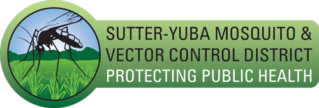The Sutter-Yuba Mosquito and Vector Control District gives notice that it intends to continue to control immature and adult mosquitoes in the District as necessary to protect the public’s health. Applications may be made between January 1 and December 31, 2024. However, the majority of applications occur between May 1 and October 31. Application of pesticides is predicated on mosquito abundance as determined by the District’s extensive surveillance system. Actual use varies annually depending on mosquito and vector-borne disease activity.
Our District follows an Integrated Mosquito Management (IMM) program that is an ecosystem based strategy. It focuses on long term prevention of mosquitoes through a combination of techniques such as biological control, habitat manipulation and pesticides. Pesticides are used only after monitoring indicates they are needed according to established guidelines. Treatments are made with the goal of eradicating only mosquitoes. Pesticides are selected and applied in a manner that minimizes risk to human health, beneficial and non target organisms, and the environment. These materials are registered by the US Environmental Protection Agency and applied according to label directions by the District’s trained and certified technicians.
Below is a comprehensive list of the active ingredients the District may use in 2024:
| LARVAL MOSQUITO CONTROL: | ADULT MOSQUITO CONTROL: |
| Bacillus thuringiensis subsp. Israelensis (Bti) Bacillus sphaericus (Bs) Beauveria bassiana Diflubenzuron Methoprene Monomolecular Films Petroleum Distillates Pyriproxyfen Spinosad Temephos |
Beauveria bassiana Bifenthrin Deltamethrin Etofenprox Lambda-Cyhalothrin Malathion Naled N-octyl bicycloheptene dicarboximide (MGK-264) Piperonyl butoxide (PBO) Permethrin Prallethrin Pyrethrin Resmethrin Sumithrin |
